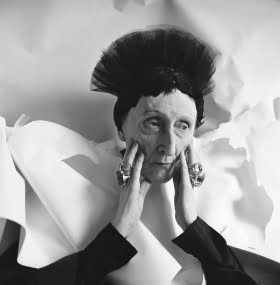After 30 Years, a New Edith Sitwell Biography

Poet and biographer Richard Greene, who teaches at the University of Toronto and won a Governor General's Literary Award in 2010, has written a new biography of Dame Edith Sitwell (1887-1964), reports the Montreal Gazette. Long overdue (the last bio of Sitwell was A Unicorn Among Lions, published in 1981), Edith Sitwell: Avant Garde Poet, English Genius is reportedly full of the barbed-wire witticisms Sitwell was famous for (hmm: "Greene explains Sitwell's vicious remarks as a way of keeping human suffering at bay"), and should do well in the drama department. Notoriously scornful, Sitwell also possessed an unequaled generosity, often befriending and promoting young writers like Dylan Thomas and Denton Welch (in fact, she wrote the foreward to Welch's most excellent Maiden Voyage). Sitwell was also famous for her striking appearance. As Jeffrey Meyers writes (keep in mind that Meyers is the biographer of one Wyndham Lewis) in The Globe and Mail:
She wore elaborate gowns, Spanish capes, medieval wimples, Turkish turbans, barbaric necklaces, clanging bracelets and lumps of turquoise and amber on her spidery fingers, all of which accentuated her weird appearance.
Sitwell was arrogant and vain, and paradoxically vulnerable yet aggressive, kind yet cruel, sensitive to suffering yet eager to inflict pain. Jealous of rival poets, she bore “like the Turk no rival near the throne.” Anyone who dared to criticize her became an enemy, and she carried on protracted guerrilla warfare with Arnold Bennett, D.H. Lawrence, Robert Graves, Noël Coward and Stephen Spender, as well as with Wyndham Lewis. He painted the brilliant portrait, now in the Tate Gallery. Though he found her repulsive, he tried to seduce her to see what the formidable virgin would be like in bed.
Hopefully Greene focuses some on the work itself. So far, from the Gazette:
As Greene points out, it was Sitwell's acute ear and her enthusiasm for the visual art of prewar Europe that informed her synesthetic poetic style. Think of much-quoted lines like "Jane, Jane, tall as a crane," and the opening verse of Façade, her collaboration with composer William Walton: "When / Sir / Beelzebub called for his syllabub in the hotel in Hell ." Her poetry, heavily influenced by the Symbolists, has the jangling pulses of Stravinsky and the sharp angles of the cubists. Her themes are fairly conventional—the self, the war—but it is her abstract approach that is so arresting.
Meyer's position on the subject is less admiring:
George Orwell, in a passage not quoted by Greene, condemned Sitwell’s “completely frivolous emphasis on technique, treating literature as a sort of embroidery, almost as though words did not have meanings.” Lines such as “Beelzebub called for his syllabub in the hotel in Hell” ran counter to Hemingway’s modern statement that poetry “is architecture, not interior decoration, and the Baroque is over.”
By comparing Edith Sitwell to her close contemporary, Russian Anna Akhmatova (1889-1966), one clearly sees the difference between a truly great poet, courageous character and noble spirit, and a malicious, self-adulating but still interesting versifier of the second rank.
Edith Sitwell is worth more than such a darting glance, however, for those avant-gardists or otherwise "interesting versifiers" we might feel akin to today. Por ejemplo, Benjamin Friedlander in the Chicago Review (cf. issue 51:4/52:1) noted Sitwell's influence on Lisa Robertson: "'Lisa ends XEclogue by citing Edith Sitwell—'my constant companion.' A curious coincidence. I found 'dark ages clasp the daisy root' in Sitwell’s Book of Flowers—a line from Finnegans Wake which Andrew Schelling and I took as the name of our second magazine. Later, Tom Mandel accused us of cultivating a fascist nostalgia for the earth. . . ."


